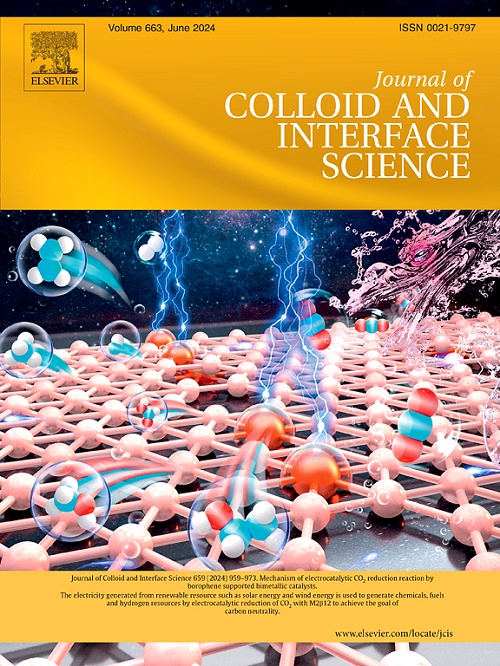Self-oxygenating nanoplatform integrating CRISPR/Cas9 gene editing and immune activation for highly efficient photodynamic therapy
IF 9.4
1区 化学
Q1 CHEMISTRY, PHYSICAL
引用次数: 0
Abstract
Photodynamic therapy (PDT) has arisen as a promising method due to its spatiotemporal precision and minimal invasiveness. It encounters significant obstacles in solid tumors due to hypoxia-induced therapeutic resistance and the self-protective mechanisms of cancer cells facilitated by MutT homolog 1 (MTH1), an enzyme involved in oxidative damage repair. Herein, we fabricate a tumor-microenvironment responsive CRISPR nanoplatform based on hollow mesoporous manganese dioxide (H-MnO2) for PDT. This platform utilizes H-MnO2 to produce oxygen (O2) through the decomposition of hydrogen peroxide (H2O2) in TME, thereby mitigating hypoxia and enhancing reactive oxygen species (ROS) generation. The high concentration of glutathione (GSH) and hyaluronidase (HAase) in TME induces the release of CRISPR/Cas9 ribonucleoproteins (RNP) to target the MTH1 gene, thereby impairs oxidative damage repair pathways and amplifys ROS-mediated cytotoxicity. The released Mn2+ ions function as immunomodulatory agents, activate innate immune responses via stimulating STING signal pathway. In vitro, IHMRH NPs markedly increased intracellular O2 levels, ROS production, lipid peroxidation and DNA damage, leading to tumor cell death, immune activation, and effective gene editing. In vivo, the nanoplatform suppressed tumor growth, diminished MTH1 gene expression, stimulated dendritic cell (DC) maturation through immunogenic cell death (ICD). This multimodal nanosystem may amplifies oxidative stress, collaborates with innate and adaptive immune activation to surpass the constraints of traditional PDT. The research presents a novel framework for cancer combination therapy by systematically integrating nanotechnology with precision gene editing.

整合CRISPR/Cas9基因编辑和免疫激活的自充氧纳米平台,用于高效光动力治疗
光动力疗法(PDT)因其时空精度和微创性而成为一种很有前途的治疗方法。由于缺氧诱导的治疗抵抗和癌细胞的自我保护机制(参与氧化损伤修复的酶MutT同源物1 (MTH1)),它在实体肿瘤中遇到了重大障碍。在此,我们基于中空介孔二氧化锰(H-MnO2)为PDT制备了肿瘤微环境响应CRISPR纳米平台。该平台利用H-MnO2通过TME中过氧化氢(H2O2)的分解产生氧气(O2),从而缓解缺氧,增强活性氧(ROS)的生成。TME中高浓度的谷胱甘肽(GSH)和透明质酸酶(HAase)诱导CRISPR/Cas9核糖核蛋白(RNP)释放靶向MTH1基因,从而破坏氧化损伤修复途径,放大ros介导的细胞毒性。释放的Mn2+离子作为免疫调节剂,通过刺激STING信号通路激活先天免疫应答。在体外,IHMRH NPs显著增加细胞内O2水平、ROS产生、脂质过氧化和DNA损伤,导致肿瘤细胞死亡、免疫激活和有效的基因编辑。在体内,纳米平台抑制肿瘤生长,降低MTH1基因表达,通过免疫原性细胞死亡(ICD)刺激树突状细胞(DC)成熟。这种多模态纳米系统可以放大氧化应激,协同先天和适应性免疫激活,从而超越传统PDT的限制。该研究通过系统地将纳米技术与精确基因编辑相结合,提出了癌症联合治疗的新框架。
本文章由计算机程序翻译,如有差异,请以英文原文为准。
求助全文
约1分钟内获得全文
求助全文
来源期刊
CiteScore
16.10
自引率
7.10%
发文量
2568
审稿时长
2 months
期刊介绍:
The Journal of Colloid and Interface Science publishes original research findings on the fundamental principles of colloid and interface science, as well as innovative applications in various fields. The criteria for publication include impact, quality, novelty, and originality.
Emphasis:
The journal emphasizes fundamental scientific innovation within the following categories:
A.Colloidal Materials and Nanomaterials
B.Soft Colloidal and Self-Assembly Systems
C.Adsorption, Catalysis, and Electrochemistry
D.Interfacial Processes, Capillarity, and Wetting
E.Biomaterials and Nanomedicine
F.Energy Conversion and Storage, and Environmental Technologies

 求助内容:
求助内容: 应助结果提醒方式:
应助结果提醒方式:


